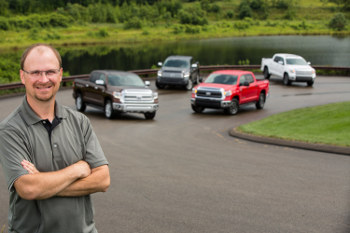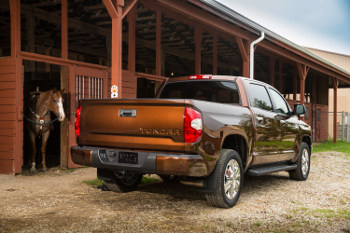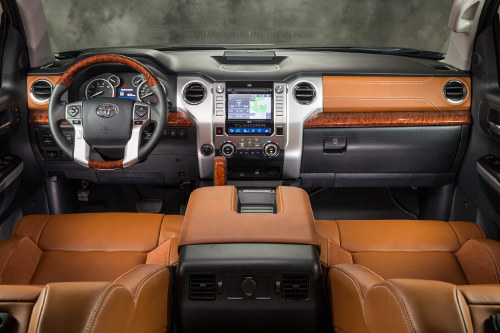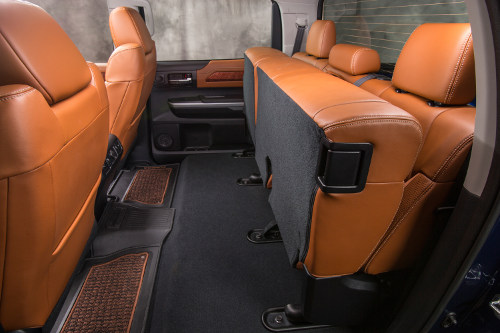 |
| September 03, 2013 | Volume 09 Issue 33 |
Designfax weekly eMagazine
Archives
Partners
Manufacturing Center
Product Spotlight
Modern Applications News
Metalworking Ideas For
Today's Job Shops
Tooling and Production
Strategies for large
metalworking plants
Wheels:
Michigan hay farmer heads 2014 Toyota Tundra pickup truck development

Mike Sweers, chief engineer of Toyota pickup trucks, in front of the 2014 Toyota Tundra lineup.
Mike Sweers is living the dream of every kid who was raised in farm country: He gets paid to create trucks. Sweers, who still runs an active hay farm in Northern Michigan, has used his mechanical engineering degree, and life experiences as a farmer, to aid him as the chief engineer of Toyota pickup trucks; especially the development of the new 2014 Tundra full-size pickup.
"I have a Tundra Double Cab with an eight-foot-long bed that I use on the farm all the time," Sweers says. "We raise hay, make maple syrup, and we have some dairy cattle that my kids show at fairs. I use the truck as a truck, which means it's had a rough life in a short period of time. Daily hard driving of the truck allowed the farm to become a personal proving ground for my own development research on the new Tundra."
Development of the new Tundra, which began in the summer of 2010, was the result of great teamwork from TTC engineering, Calty designers, and the team members at TMMTX. Sweers and his engineering team worked closely with Calty Design Research, Inc., President Kevin Hunter and his design teams at Toyota's design centers in Newport Beach, Calif., and Ann Arbor, Mich. Engineering discussions began early at the sketch level as they strived for a bold exterior design from the very start. As sketches were modified, the use of computer-aided-design (CAD) enabled the team to check the early designs' stamping feasibility on the fly, a process that was much quicker than in the past.
Sweers and his team also had a vision where each Tundra grade would be unique. Research showed customers want their trucks to look different and reflect their individuality. They want people to recognize they are driving something special when they see them in a Tundra Platinum or the new 1794 Edition.

The final design resulted in a powerful exterior to embody the Tundra's performance capabilities. The front design featured a bold front end with a higher hood line that is integrated into the grille for a chiseled and modern industrial image.
"With the chiseled styling and bold appearance on the front end, it delivers the message of Tundra's capability and announces that we are a truck to be reckoned with in the industry," Sweers says.
Sweers' own experiences with damaged bumpers on the farm led to the design of three-piece front and rear lower bumpers, allowing for lower replacement costs. Fenders and wheel wells have been squared-off for a wide and sturdy stance. A new bed and tail gate has an integrated spoiler and "TUNDRA" stamped into the sheet metal, creating a one-piece forged look. The redesigned tail lamps express a tool-like quality to match the appearance of the body.
"Our goal was to make a truck that is more traditional, more chiseled, and emphasizes the outstanding power and performance of the truck," Sweers says. "The final product is actually very close to the original sketch. It is a very polarizing design, and one that I would want!"
Sweers was previously the vice president of interiors at Toyota Technical Center (TTC) in Ann Arbor, which was a big advantage in developing the new, refined interior. Calty worked closely with his engineering team and product planners to come up with the design for the new Tundra interior. Key design elements of the new interior include a new front dash with a center stack that was moved 2.6 in. closer to the driver, putting all controls within easy reach. The slide and recline of the rear seat on the CrewMax grade now folds up, catering to customer demands for additional interior storage space. Refinement was a top priority, as all Tundra grades were designed with newly structured seats and premium leathers and fabrics for more comfort and eye appeal.
"With the interior, we wanted to go after a refined look and feel to complement the bold exterior design," Sweers says. "We really focused on craftsmanship and premium interior materials, looking at colors and grains and textures.

"We also added technologies our customers would appreciate, such as our updated Entune Audio system, with a larger touch screen, a standard back-up camera, and the first full-size truck with a Blind Spot Monitor with Rear Cross Traffic alert." Sweers adds. "My goal was to show the true quality of the truck and raise the bar for refinement in the segment."

Once the design was complete, Sweers recruited the help of 30 of the best and brightest team members from the manufacturing home of the Tundra, Toyota Motor Manufacturing, Texas (TMMTX), in San Antonio. The 30 team members were brought up to TTC Ann Arbor for two months to help the Product Engineering team hand-build the first test units.
"Having the help of the 30 team members from TMMTX was invaluable to the entire project," Sweers says. "It helped us realize what we needed to change from an engineering standpoint, but it was also a benefit to TMMTX as it assisted them in determining what they may need to change on the production line."
The full-size pickup truck segment is arguably the most competitive in the automotive industry. To be the best truck in the segment, you have to know what makes the competition so good. Early in the development of the new Tundra, Sweers and his team dissected all competitors' trucks. They looked at every nut and bolt -- how the competitors put their trucks together, and how they marketed their trucks. Sweers and his team looked at their specifications and grade packages, and even their price points.
"Our goal is to make the best truck in the industry," Sweers says. "We tried to pay attention to every detail, no matter how big or small, because it's the details that really help sell a truck. I think from a drivability standpoint, and from where our competitors have gone, I think we may be a little bit better."
"I feel the new Tundra reflects the future of where trucks are going," Sweers adds. "The new styling really emphasizes how bold and capable our truck actually is. The fact we've had the most reliable truck seven of the past eight years according to J.D. Power and Associates is not by accident. It's by design."
Source: Toyota
Published September 2013
Rate this article
View our terms of use and privacy policy
